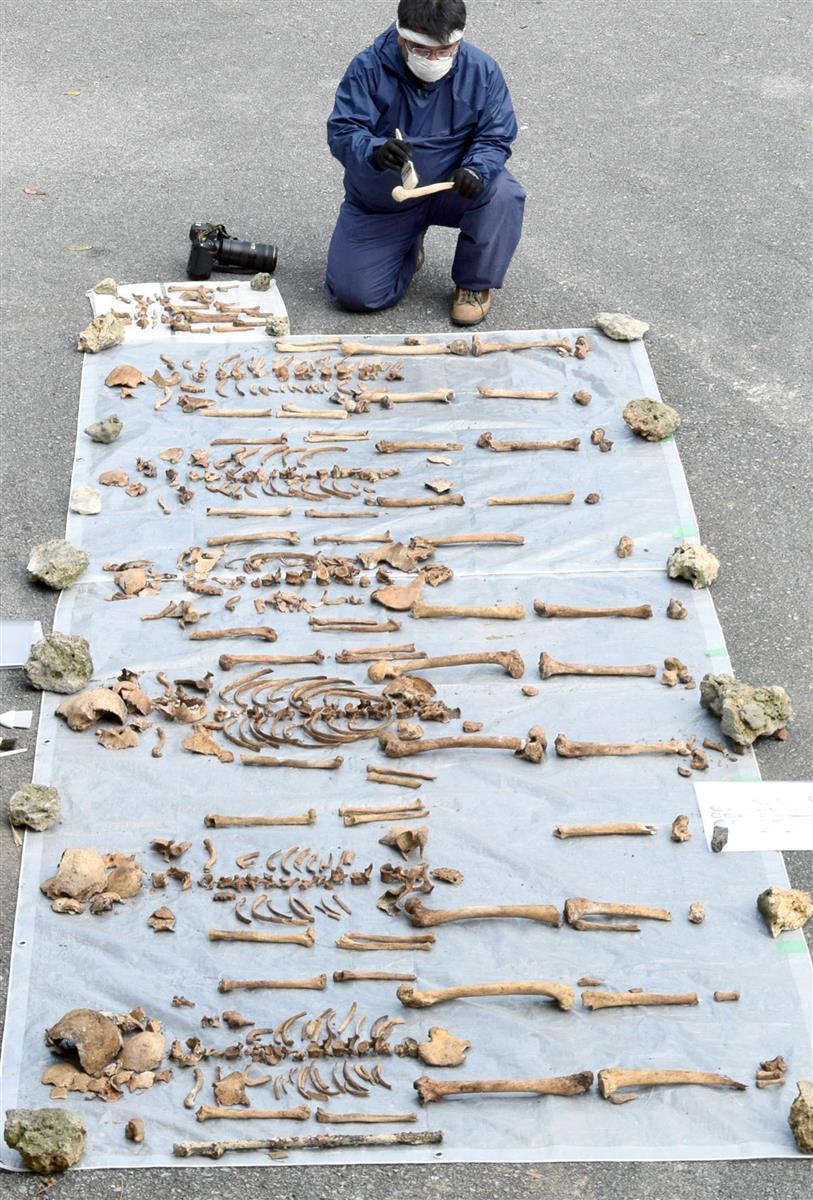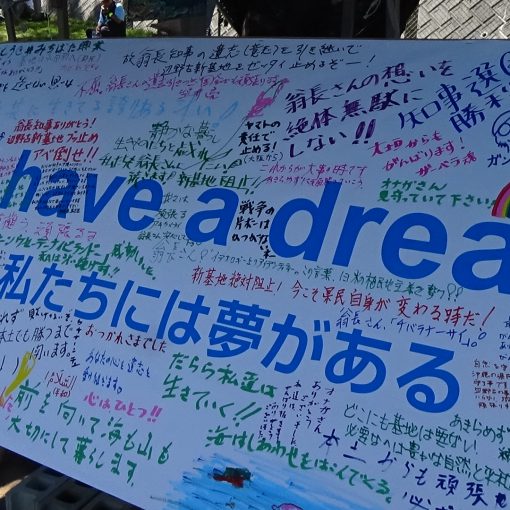Mar 5 (Fri)
We have got used to camping. We can efficiently remove the bed to set our tents for daytime use. We joke that we can have our tents named “Guest House in front of Prefectural Office.”
We check newspapers bought at a nearby convenience store: The hunger strike is featured in many papers every day. Many people came for encouragement about 10:00 this morning, too. The number of signatures, including those online, has exceeded 20,000. The circle of sympathy is rapidly spreading.
Big news came: the remains of eight war-dead persons, including two children, unearthed in Itoman. Mr. Tetsuji Hamada, a photographer, and his wife, Ritsuko, found them intact as a whole body without loss. The couple and Mr. Gushiken have been active in collecting remains for about twenty years. ”Most of the victims’ families are not giving up for the remains returned to the families,” said Mr. Hamada. Another news reported recovery of the remains of two other persons in Yoza, Itoman. The memory of the war rises freshly still now, 75 years after the war, in Okinawa.
”Remains cannot be discovered in such good conditions if a heavy-duty machine moves the surface soil. The remains were in a bunker 10 meters deep in the ground. It has proved wrong that no bones and ashes remain if we remove the surface soil,” said Mr. Gushiken, who explained it many times to the visitors, with Mr. Hamada’s photos in hand, this day. He believes that the bombing destroyed and blocked the cave shelters’ entrances and buried many people alive within the cave. And many cave shelters are still deep in the ground undiscovered.
Mr. Gushiken appealed plangently with a microphone to the prefectural office. “Please help. Please help the remains. Governor Denny, please listen to the voices of the victims’ families.”
Governor Denny, expected to come for encouragement, has not arrived yet. The hunger strike supporters decided to restart a strike next week if the Governor does not come tomorrow. They also agreed to continue the campaign for collecting signatures.
In Takae, Akino Miyagi (a collector of butterflies) is also on a hunger strike alone in front of the U.S. Military Northern Training Area gate. Another person in Hokkaido is on a hunger strike outdoors, in solidarity with Mr. Gushiken, too. He must feel so cold.
Much encouraging news comes every day. On the last night of the hunger strike, being acclimated to the feeling of hunger, I fell into sleep with daytime excitement.
Mar 6 (Sat)
Even on the sixth of the hunger strike, Mr. Gushiken has more vitality than the other three members. He is polite with persons who visited for encouragement and media reporters. He spoke to the victims’ families of the Battle of Okinawa, who live in Okinawa and other prefectures, through the camera. “I am so afraid that we may end up throwing your father, grandfather, or brother into the sea of Henoko,” said he.
At about 9:30 a.m., Governor Denny Tamaki arrived suddenly in plain clothes. He listened to Mr. Gushiken quietly with sincerity. ”Please don’t decide on this problem only with you and your stuff in charge. What the bereaved think and feel should be taken into consideration and placed on the top priority. Discuss with experts, too,” said Mr. Gushiken.
“The sentiment of Uchinanchus (Okinawans) will never approve the collection of the soil that contains the remains. I am seeking with my heart and soul some legally-binding measures for preventing the collection,” said Governor Denny Tamaki. “At the war, many people, from little children to elderlies, died. I am against the use of the soil that contains the remains for the landfill, which will place the dead in permanent suffer,” appealed Nami Kikuzato (a fifth-grader in an elementary school), looking straight into the Governor’s eyes.
More than 200 people attended a rally in the afternoon. Some of the victims’ family members, around 90 years of age, told their ground battle experience one after another in tears. “I have not found the remains of my father yet. In place of his ashes, my family placed the stones in his grave. We collected stones from where we believe he died,” Chiyoko Hirayama (80) told us. “I could not stop my tears when I heard that the military base construction would use the soil with the remains for landfill. I am too shocked to say anything,” said Hajime Toyoda (92).
Mr. Gushiken raised the last voice this day to the prefectural office. “There are few things that are absolutely wrong in the world, but I say that to use the soil that contains the remains for the military base construction is absolutely wrong. Governor Denny, please listen to the voices of the bereaved families. Please help us.”
A young woman who had collected 648 online signatures came and said, “Mr. Gushiken has appealed, risking his life. It is all I could do.”
All Okinawa Coalition made a public protest statement and announced that they would continue the future campaigns with Mr. Gushiken.
We have exposed an inhumane Japanese government’s plan to use the soil that contains the remains of the war victims for military base construction to many people in Japan and other countries.
An action of a single person, “Gamafuya,” is stirring the heart of Uchinanchus and people in Japan and other countries. We learned the fact and realized that we as humans should never do it, whether it is legal or not.



Number of dump trucks to date and percentage against the total
The estimation calculated on the basis of the number of ruckloads serves only as a reference.
Number of dump trucks which made delivery from December 2018 to the end of December 2020 302,705(3.746%)
| 6(Wed) | 8(Thu) | 9(Fri) | 10(Sat) | 11(Mon) | 12(Tue) | |
| Awa | 662(3) | 925(3) | 918(4) | 918(4) | 875(4) | 718(5) |
| Shiokawa | 0 | 706(5) | 711(5) | 711(5) | 893(2) | 261(2) |
| Number of dump trucks ※ |
Weightt of earth/sand
※① |
Converted to volume
※② |
Volume per Total
※③ |
| 354,132 | 1,770,660 t | 885,330㎥ | 4.383 % |
※ Cumulative since Dec. 1, 2019
※① Calculated by assuming that the average truckload per dump truck would be 5 tons
※② Calculated by assuming that a specific weight of soil/sand set to be 2
※③ Percentage against 20.200.000m3, the total volume of earth and sand required for the landfill.



